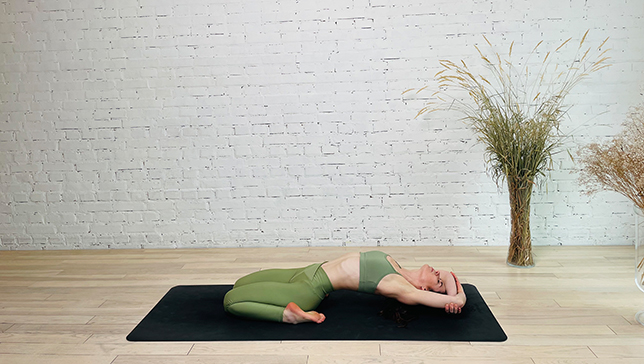Couch Pose - Paryankasana

Contents
Couch Pose or Paryankasana is an intermediate backbend, performed while the legs are held in virasana. For the yogi to perform this posture, they must have developed flexibility in the ankle, knee and hip joints, as well as the quadriceps, which allow the yogi to feel stable as they move towards Paryankasana. Without stability in the legs and hips, the legs can open too widely as the body reclines towards the mat, which can compress the back.
When translating from Sanskrit, ‘Paryanka’ means a bed or couch and ‘Asana’ translated to pose or posture. A moderate to hard pose, couch pose is part of the backbend family and shapes the body to resemble a couch, giving this pose the apt name.
Your knees and ankles need to be flexible when doing this pose, but there are also many variations and modifications you can make to perform couch pose with comfort and ease.
Pose Detail
- By Type: Chest Opening Yoga Poses, Flexibility Yoga Poses, Hip Opening Yoga Poses, Shoulder Opening Yoga Poses, Strengthening Yoga Poses
- Difficulty: Intermediate
- Body Position: Supine Yoga Poses
- By Benefit: Yoga Poses For Digestion
Step-by-Step Instructions
Benefits and Contraindications
Stretches the feet, quadriceps and ilio-psoas
Stretches the respiratory diaphragm and the abdominal organs
Opens the lungs and chest
Benefits the thyroid and parathyroid as the anterior neck spine is stretched and toned
Helps with lymph drainage, as the lymph flows from abdomen into the chest and supports lymph drainage under the collar bones
Benefits the vocal cords
Hypertension
Cardiac problems
Knee injuries
Stiffness in the lower back and neck
Sciatica
Pregnancy
Photo poses in different angles

Modifications, Props and Tips
- If you have discomfort in bringing your sit bones to the mat, sit on a bolster or a cushion.
- You can place a bolster or a block behind you for comforting your thoracic spine. Make sure that as you recline, the prop is pressing into your back and is under your scapulae or slightly lower but not in the middle of your back.
- You can give comfort to your back support/props like a block or bolster under your head or lower back.
- For added support to the hips, hold your thighs together and tie a yoga belt around the knees. This modification not only makes you comfortable in the pose but also gives you the same benefits of the asana.
Frequently Asked Questions
Here are some common mistakes to avoid when practicing Paryankasana:
- Overarching the lower back: When practicing Paryankasana, it’s important to maintain a neutral spine position. Avoid arching your lower back, as this can put pressure on your lumbar spine and lead to discomfort or injury.
- Letting the knees fall apart: To maintain proper alignment in Paryankasana, keep your knees together and your feet parallel to each other. Letting your knees fall apart can strain your hip joints and lower back.
- Tucking the chin: To avoid compressing your neck, keep your chin slightly tucked and your neck long. Avoid letting your head hang back or jutting your chin forward.
- Holding your breath: Breathing is an essential part of yoga practice, and it’s important to maintain steady, rhythmic breathing throughout Paryankasana. Avoid holding your breath or taking shallow breaths.
- Pushing yourself too far: As with any yoga pose, it’s important to listen to your body and work within your own limits. Avoid pushing yourself too far into the pose, as this can lead to injury or strain.
- Lifting the shoulders off the ground: Keep your shoulders relaxed and pressed into the ground. Avoid lifting your shoulders up towards your ears, as this can create tension in your neck and shoulders.
By avoiding these common mistakes, you can practice Paryankasana safely and effectively. Remember to always listen to your body, and work within your own limits. If you have any concerns about your form or alignment, seek the guidance of a qualified yoga instructor.
Yes, it can be practiced by beginners as well as advanced practitioners. This pose is relatively simple and accessible, and can be modified to suit a range of abilities.
However, as with any yoga pose, it’s important to approach Paryankasana with awareness and caution. It’s best to practice this pose under the guidance of a certified yoga teacher who can help you understand proper alignment and technique, and can offer modifications or adjustments as needed.
Yes, Paryankasana, also known as Couch Pose or Hamstring Stretch Pose, can be helpful in alleviating lower back pain. This pose stretches the hamstrings, glutes, and lower back muscles, which can help to release tension and tightness in these areas.
Lower back pain can be caused by a variety of factors, including poor posture, tight muscles, and weak muscles. By practicing Paryankasana, you can stretch and strengthen the muscles in your lower back, hips, and legs, which can help to improve your posture and reduce pain and discomfort.
However, it’s important to note that if you have a serious or chronic lower back condition, such as a herniated disc or sciatica, you should consult with a healthcare professional before practicing Paryankasana or any other yoga pose. They can help you determine if this pose is safe and appropriate for your specific condition, and may recommend modifications or alternative poses to help alleviate your lower back pain.